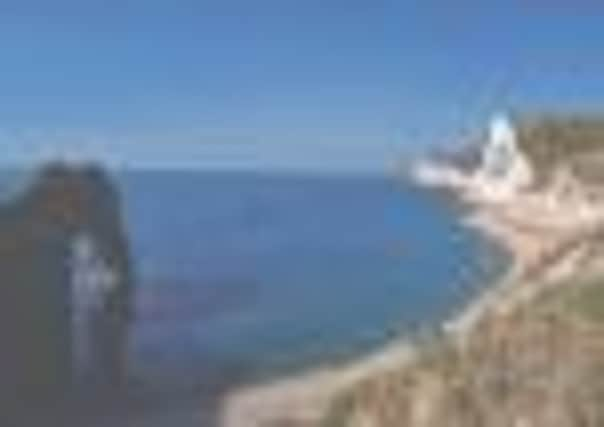Travel: The Dorset coast


The immense, dragon-like skull leered at us from 195 million years ago, all tooth-crammed jaws and empty eye sockets. It was the first ichthyosaur, a prehistoric fish-lizard, to be unearthed by renowned fossil collector Mary Anning from the seashore rocks near her home in Lyme Regis, Dorset.
In actuality, it was Anning’s brother, Joseph, who found the head in 1811, while Mary, just 12 at the time, tracked down the neck section some months later. The ichthyosaur was on loan to Lyme Regis Museum from the Natural History Museum in London.
Advertisement
Hide AdLyme Regis was the starting point for our 11-day walk along Dorset’s spectacular “Jurassic Coast”, which, along with the neighbouring east Devon coastline, is designated a UNESCO World Heritage site because of the unique geology of its sea-eroded cliffs, their exposed strata rich in fossils from the period when giant reptiles ruled the Earth.
Our “self-guided” walking tour included comfy B&B accommodation along the way and luggage transferred from stop to stop, leaving us to hoof it, following printed instructions which were generally pretty clear, although the South West Coast Path national trail guide also proved useful.
Prehistory is a major industry here. Lyme itself, once a fashionable spa town (Jane Austen was a visitor) and still a bustling resort, is full of fossil shops, while a restaurant calling itself Jurassic Seafood, contrary to what one might surmise, does not serve 100-million-year-old prawns. We took a guided fossil walk along the shore with collector Paul Crossley, who helped us unearth some of the more common fossils, the “devil’s toenails” which are in fact prehistoric shellfish, and the ubiquitous whorled ammonite shells which are reproduced everywhere, including on the town’s antique-style lampposts.
It’s not all prehistory, however. A stroll along Marine Parade of a late summer evening found the place still in full holiday fling, the seaweed tang from the pebble beach vying with the alluring odour of chips and vinegar from innumerable counters. From the sweep of the Cobb, the town’s ancient harbour wall – made famous by a cowled Meryl Streep in The French Lieutenant’s Woman – the author of which, John Fowles, lived in Lyme – we watched the setting sun illuminate Golden Cap, at 626ft the highest point on England’s south coast and lying along our route eastward.
The Dorset coast is the most active landslip area in Europe – a major one in 2008 saw a 400m section of cliff between Lyme Regis and Charmouth thunder on to the beach. Such geology in motion makes the concept of the SW coastal route a somewhat malleable one, as paths vanish into thin air.
Further east, we stayed in the picture postcard village of Abbotsbury, with its honeyed stone and thatch cottages, its swannery and sub-tropical gardens. We followed the 17-mile pebble embankment of Chesil Beach to the Isle of Portland, famed for its white stone, used to re-build London after the Great Fire. At its southerly tip, Portland Bill, a gale was driving lumps of gun-metal sea to explode against the rocks.
Advertisement
Hide AdWe spent a night in the cosy old Smugglers’ Inn, nestling among the cliffs at Osmington Mills, although the thunderous clatter of low-flying rotor blades in the dark suggested rather different nocturnal activities. There were 21st-century incursions, too, between picturesque but crowded Lulworth Cove, with its famous Durdle Door natural arch, and our route’s most easterly point of Kimmeridge.
From Lulworth, we took a bus inland to Bovington Camp and walked the “TE Lawrence Trail” to Clouds Hill cottage, where Lawrence of Arabia lived the last years of his life, and the village of Moreton, where he is buried at the little church of St Nicolas.
Advertisement
Hide AdThe trail took us through pine woods and heather, Thomas Hardy’s “Egdon Heath”, which he described in The Return of the Native as “a face on which time makes but little impression”. Back on the coast, however, time and tide both leave an indelible impression, in the perpetual battle between the sea and those fossil-rich cliffs.
THE FACTS
Encounter Walking (www.encounterwalkingholidays.com) specialise in walking holidays with luggage transfer along the South West Coast Path, starting at £199 for a three-night break, with a one-week tailor-made walk costing from £440 per person. Jim travelled by train to Lyme Regis from Edinburgh to London King’s Cross, then from Waterloo to Axminster, and a 20-minute bus run to Lyme Regis.
A standard return, Edinburgh to London King’s Cross, starts at £33,
www.eastcoast.co.uk; www.jurassiccoast.com